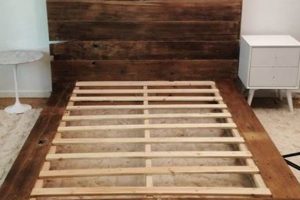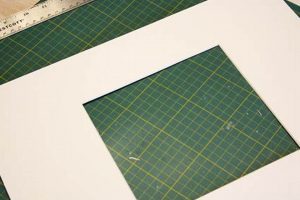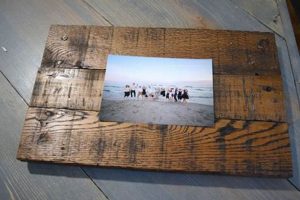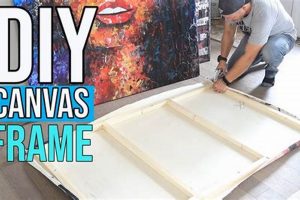A structure combining the functions of a bed frame and a bookcase is a furniture piece offering dual utility. These units commonly incorporate shelving or storage compartments into the headboard or side rails, providing accessible space for books, decorative items, or personal belongings. The integration creates an efficient solution, particularly valuable in smaller living spaces where maximizing storage is essential. As an example, one might construct such a unit using readily available lumber and prefabricated bookcase components, customizing the size and configuration to suit specific needs.
The rise in popularity of combined bed frame and bookcase designs is tied to increasing urbanization and the subsequent demand for space-saving furniture. Such constructs offer organizational benefits, reducing clutter and streamlining room layouts. Historically, furniture has evolved to meet the challenges of limited space; this specific adaptation represents a contemporary response to the ongoing need for compact, multi-functional designs.
Subsequent sections will detail the construction process, materials considerations, design variations, and safety measures applicable to crafting integrated bed frame and bookcase systems. The focus will remain on providing practical guidance for individuals seeking to create customized furniture solutions.
Construction Considerations
The following provides guidance for the successful design and assembly of an integrated bed frame and bookcase structure. Careful attention to detail and adherence to safety standards are paramount throughout the project.
Tip 1: Material Selection: Choose lumber appropriate for structural support, such as kiln-dried hardwood or high-quality plywood. Ensure the wood is free from significant knots or warping to maintain stability.
Tip 2: Precise Measurements: Accurately measure the intended mattress dimensions and the available space to avoid errors in the frame’s overall size. Account for mattress overhang or any desired aesthetic additions.
Tip 3: Structural Integrity: Reinforce joints using screws, dowels, or metal brackets to prevent loosening or separation over time. Adequate support is crucial for safety and longevity.
Tip 4: Bookcase Integration: Plan the bookcase configuration carefully, considering the weight it will bear. Distribute weight evenly across shelves to prevent sagging or collapse.
Tip 5: Safety Considerations: Ensure all edges are rounded or sanded smooth to minimize the risk of injury. Secure the structure to the wall, particularly if it is tall or potentially unstable.
Tip 6: Weight Distribution: Consider the final weight distribution of the complete structure when placing on any floor surface. Ensure that the load is not concetrated in small area but evenly distributed for optimal longetivity of the structure and your floor.
Tip 7: Ventilation: If the design encloses the mattress significantly, provide adequate ventilation to reduce moisture buildup and potential mold growth.
Tip 8: Accessibility : Consider the accessibility of shelves and drawers in bookcase part. Make sure user can easily access all storage.
These considerations will aid in building a functional, safe, and aesthetically pleasing integrated unit. Prioritization of material quality and structural reinforcement will contribute significantly to the durability of the finished product.
The following sections will address specific design styles and provide detailed assembly instructions, allowing for customization and personalization of the integrated bed frame and bookcase.
1. Dimensions
Dimensional accuracy is paramount to the successful integration of a bookcase into a bed frame. Incorrect measurements can compromise structural integrity, aesthetic appeal, and user comfort. The following outlines critical dimensional facets for such projects.
- Mattress Compatibility
The bed frame’s internal dimensions must precisely match the mattress size (e.g., Twin, Full, Queen, King). Allowing for a slight tolerance (e.g., 1/4 inch) prevents a too-tight or too-loose fit, ensuring comfort and preventing mattress damage. An undersized frame renders the mattress unusable, while an oversized frame creates instability.
- Room Space
External dimensions must account for available room space, including ceiling height, doorway widths, and clearances for movement. A design exceeding spatial constraints is impractical. Furthermore, consider placement relative to windows, doors, and electrical outlets to maintain functionality.
- Bookcase Proportions
Bookcase dimensions (height, width, depth) impact both aesthetics and structural load. Taller bookcases require greater depth for stability. Shelf height must accommodate intended contents (e.g., books, decor). Excessive shelf depth reduces usable space and accessibility. Weight of the books should also be considered when planning for shelf depth.
- Ergonomics
The overall height of the bed frame, including the mattress, should facilitate comfortable entry and exit. Shelf placement within the bookcase component should allow easy access without excessive reaching or bending. The horizontal length and thickness will determine overall comfort and sturdiness of the bed frame structure.
Careful attention to dimensional accuracy throughout the design and construction phases is essential for achieving a safe, functional, and visually harmonious integrated bed frame and bookcase unit. Disregard for these dimensional facets can result in structural weaknesses, unusable storage space, and compromised user experience.
2. Materials
Material selection exerts a defining influence on the structural integrity, aesthetic qualities, and overall longevity of a bed frame incorporating a bookcase. The choice of materials directly impacts the project’s cost, difficulty of construction, and suitability for various environments.
- Wood Species and Grades
Different wood species exhibit varying strengths, densities, and resistance to moisture. Hardwoods like oak, maple, and birch provide superior load-bearing capacity suitable for supporting both a mattress and a loaded bookcase. Softwoods such as pine or fir, while more affordable, may require reinforcement or are better suited for decorative elements. Wood grades indicate the presence of knots or imperfections, impacting structural soundness and visual appeal. Higher grades are less prone to warping or splitting.
- Engineered Wood Products
Plywood, MDF (Medium-Density Fiberboard), and particleboard offer alternative material options. Plywood provides good strength and dimensional stability, particularly for structural components. MDF delivers a smooth surface ideal for painting or veneering. Particleboard is the least expensive but also the least durable, suitable primarily for non-load-bearing panels. These materials exhibit consistent dimensions and are less prone to expansion or contraction compared to solid wood.
- Fasteners and Adhesives
Screws, nails, bolts, and wood glue play crucial roles in joining components securely. The type and size of fasteners must match the materials being joined and the anticipated stress loads. Wood glue, specifically formulated for woodworking, creates strong, durable bonds. Metal fasteners, such as screws and bolts, provide mechanical reinforcement, particularly at critical joints. Consideration must be given to the compatibility of adhesives with the chosen wood finish.
- Finishes and Sealants
Surface finishes protect the wood from moisture, scratches, and UV damage, while also enhancing its aesthetic appeal. Paint, stain, varnish, and lacquer are common options. Sealants prevent moisture penetration, which can lead to warping or rot. The choice of finish should align with the intended use and environmental conditions. For example, a bed frame in a humid environment may require a waterproof sealant.
The interplay between material selection and construction techniques determines the ultimate success of an integrated bed frame and bookcase. Informed choices, considering both structural requirements and aesthetic preferences, ensure the creation of a functional, durable, and visually pleasing piece of furniture. The appropriate material contributes to the long term life of the diy bookcase bed frame.
3. Stability
Structural integrity, or stability, is a paramount concern in the design and construction of a bed frame integrated with a bookcase. Instability can lead to structural failure, posing safety risks to the user. Therefore, meticulous planning and execution are essential to ensure a robust and secure construction.
- Joint Strength and Reinforcement
The connections between the bed frame components and the bookcase are critical points of stress. Weak joints can lead to wobbling, sagging, or even collapse. Employing strong joinery techniques such as mortise-and-tenon, dovetails, or reinforced screw connections is crucial. Metal brackets or corner braces can further enhance joint strength, particularly in areas subject to high stress. For example, reinforcing the joint between the bookcase uprights and the bed frame side rails is essential for preventing lateral movement. Proper joint design and selection directly impact the load-bearing capacity of the structure.
- Weight Distribution and Load Capacity
The design must account for the combined weight of the mattress, occupants, and the contents of the bookcase. Uneven weight distribution can create stress points, leading to structural weakness. Shelves within the bookcase must be capable of supporting the anticipated load without sagging or bowing. The base of the bed frame must provide adequate support to distribute the weight evenly across the floor. For instance, a wide base with multiple support legs reduces stress on any single point. Overloading the bookcase or exceeding the designed weight capacity can compromise stability and lead to failure.
- Material Rigidity and Deflection
The chosen materials must possess sufficient rigidity to resist bending or deflection under load. Excessive deflection can compromise the structural integrity and aesthetic appeal. Thicker lumber or engineered wood products are generally more rigid. Reinforcing panels with backing or cross-bracing can reduce deflection. For example, using thicker plywood for the bookcase shelves or adding a solid back panel increases their resistance to sagging. Selecting appropriate materials and incorporating reinforcement techniques minimizes the risk of structural deformation.
- Anchoring and Wall Support
In certain designs, particularly those with tall or narrow bookcase components, anchoring the structure to the wall is essential for preventing tipping. Wall anchors provide lateral support, reducing the risk of the unit overturning, especially under uneven loading. Securely attaching the bookcase to wall studs provides maximum stability. The type of wall anchor used must be appropriate for the wall material (e.g., drywall, plaster, concrete). Anchoring significantly enhances stability, particularly in homes with children or pets, preventing accidents and protecting the structure.
These facets of stability are interconnected and must be addressed holistically to ensure a safe and durable integrated bed frame and bookcase. Neglecting any aspect can compromise the overall integrity of the unit, posing potential hazards. Through careful design, material selection, and construction practices, it is possible to create a structure that is both functional and structurally sound, and ensures its safe utilization over the long term.
4. Storage Capacity
Storage capacity, in the context of combined bed frame and bookcase units, refers to the total volume available for storing items within the integrated bookcase component. This is a key design consideration, directly influencing the functionality and practicality of the furniture piece, particularly in space-constrained living environments.
- Shelf Dimensions and Configuration
Shelf dimensions (height, width, and depth) dictate the size and quantity of items that can be stored. Adjustable shelves offer flexibility in accommodating items of varying heights. The number of shelves and their spacing influence the total storage volume. A configuration with numerous closely spaced shelves maximizes storage for smaller items, while fewer, taller shelves are suitable for larger objects. The dimensions of these shelves will determine the practicality of the storage.
- Load-Bearing Capacity of Shelves
Each shelf must be capable of supporting the intended weight of stored items without sagging or breaking. Exceeding the load-bearing capacity compromises structural integrity and can lead to collapse. The material and thickness of the shelving material, as well as the support structure, determine the load capacity. Thicker shelves and reinforced supports increase weight-bearing capabilities. Distributed weight ensures stability of each shelf. The load-bearing of each shelf is not only for stability but for safety as well.
- Enclosed Storage Options
In addition to open shelving, integrated units may incorporate drawers, cabinets, or other enclosed storage compartments. Enclosed storage offers protection from dust and concealment of less aesthetically pleasing items. Drawer size and configuration influence the type and quantity of items that can be stored. Cabinets provide larger, enclosed storage spaces suitable for bulkier items. Enclosed storage is more practical in some situations when compared to open shelving.
- Accessibility and Organization
The ease with which stored items can be accessed is a critical aspect of storage capacity. Shelf placement and orientation should facilitate easy reach. Adequate lighting within the bookcase component enhances visibility and accessibility. Organizational aids, such as shelf dividers or storage bins, can improve the efficiency of storage utilization. Organization and convenience of accessibility are important features when planning storage capacity.
The storage capacity of combined bed frame and bookcase units is a multifaceted consideration, encompassing shelf dimensions, load-bearing capacity, enclosed storage options, and accessibility. Optimizing these elements maximizes the utility of the furniture piece, providing efficient and organized storage solutions within a compact footprint. Prioritizing functionality over aesthetics and optimizing all aspects of the structure ensure the longevity of the storage capacity and quality of the bookcase.
5. Accessibility
Accessibility, within the context of a combined bookcase and bed frame design, refers to the ease and convenience with which stored items can be retrieved or accessed, and the ease of use of the bed itself. It encompasses the physical reach, visibility, and ergonomic considerations that contribute to a user-friendly experience. Failing to address accessibility can negate the functional advantages of integrated storage.
- Shelf Height and Reach
The vertical placement of shelves within the bookcase component significantly impacts accessibility. Shelves positioned too high require excessive reaching, while those too low necessitate bending or kneeling. Ergonomic principles dictate that frequently used items should be placed within a comfortable reach zone. For example, locating reading materials at eye level when sitting in bed promotes ease of access. The design must consider the user’s physical capabilities to ensure comfortable and safe retrieval of stored items.
- Lighting and Visibility
Adequate illumination within the bookcase component is crucial for identifying and retrieving items, particularly in low-light conditions. Poor lighting can obscure contents, making it difficult to locate specific items. Integrated lighting solutions, such as LED strip lights or strategically placed spotlights, enhance visibility and improve accessibility. For instance, a small reading light mounted on the bookcase can illuminate the shelves without disturbing others. Good lighting is essential for maximizing the usability of the storage space.
- Obstruction and Clearance
The placement of the bed frame and bookcase relative to other furniture or architectural elements can impact accessibility. Confined spaces or obstructions can impede movement and restrict access to stored items. Sufficient clearance around the bed frame is necessary for comfortable entry and exit. The design must consider the surrounding environment to ensure unimpeded access to the storage space and the bed itself. For example, ensuring that drawers can fully extend without obstruction is essential for usability.
- User Physical Considerations
Variations in user height, mobility, and physical limitations should inform the design. Adjustable shelves or customized storage solutions can accommodate diverse needs. For individuals with limited mobility, lower shelves or pull-out storage options may be more accessible. The design should prioritize inclusivity, catering to a range of physical abilities. Consideration of universal design principles enhances the usability of the integrated unit for a wider audience.
Integrating these facets of accessibility into the design of a combined bed frame and bookcase ensures a user-friendly and functional piece of furniture. By prioritizing ease of reach, visibility, clearance, and catering to diverse physical needs, the design maximizes the benefits of integrated storage and promotes a comfortable and convenient user experience. Failure to adequately address these accessibility concerns can diminish the practicality and value of the entire unit.
6. Aesthetics
Aesthetics constitutes a critical component in the design and construction of a combined bookcase and bed frame. The visual appeal directly influences the furniture piece’s integration into the surrounding environment, impacting the overall ambiance of the room. A well-executed aesthetic design enhances the perceived value and user satisfaction. Conversely, a poorly considered aesthetic can detract from the functionality and practicality of the unit. The choice of materials, finishes, and design style dictates the aesthetic outcome.
Consider the impact of differing design styles. A minimalist approach, characterized by clean lines and neutral colors, can create a sense of spaciousness and order. Conversely, a more ornate design, incorporating intricate carvings or bold colors, can introduce character and visual interest. A rustic design, using reclaimed wood and distressed finishes, fosters a sense of warmth and authenticity. The aesthetic design should complement the existing decor and reflect the individual’s personal taste. For example, a modern bedroom might benefit from a sleek, white bookcase bed frame, while a bohemian-style room could accommodate a more eclectic, colorful design. The size of bookcase can be made with different design such as large wall-to-wall structures provide substantial visual impact, while smaller, more understated designs offer subtle integration.
Ultimately, the aesthetic considerations in constructing a combined bookcase and bed frame extend beyond mere visual appeal; they impact the overall functionality and emotional resonance of the furniture piece. A thoughtfully designed unit not only provides practical storage solutions but also enhances the aesthetic quality of the living space. Successfully balancing aesthetic considerations with structural requirements and practical needs represents a key challenge in achieving a cohesive and functional design, this results in an enduring satisfaction with the final product.
Frequently Asked Questions
The following addresses common inquiries regarding the construction and utilization of integrated bed frame and bookcase structures. The information provided is intended to offer clarity and guidance for individuals undertaking such projects.
Question 1: What is the recommended lumber for a DIY bookcase bed frame?
Kiln-dried hardwood, such as oak or maple, is recommended for structural components due to its strength and durability. High-quality plywood can be used for panels and shelving, offering a cost-effective alternative while maintaining structural integrity. Softwoods may be suitable for non-load-bearing decorative elements.
Question 2: How can structural integrity be ensured in a DIY bookcase bed frame?
Employing robust joinery techniques, such as mortise-and-tenon or dovetail joints, is crucial. Reinforcing joints with screws, dowels, or metal brackets provides added stability. Ensuring proper weight distribution and anchoring the structure to the wall enhances overall integrity.
Question 3: What safety precautions are necessary when constructing a DIY bookcase bed frame?
All edges should be rounded or sanded smooth to prevent injury. The structure should be securely anchored to the wall to prevent tipping. Weight capacity should be carefully considered to avoid overloading shelves. Adequate ventilation should be provided to reduce moisture buildup. Use of personal protective equipment during construction is essential.
Question 4: What are the key considerations for designing shelves within a DIY bookcase bed frame?
Shelf dimensions should be appropriate for the intended contents, with adjustable shelves offering flexibility. Shelf depth should balance storage capacity with accessibility. Load-bearing capacity must be adequate to support the weight of stored items without sagging. Shelf placement should facilitate easy reach and visibility.
Question 5: How can adequate ventilation be ensured in a DIY bookcase bed frame?
Incorporating ventilation holes or gaps in the bed frame structure promotes airflow. Avoiding complete enclosure of the mattress reduces moisture buildup. Selecting breathable mattress materials further enhances ventilation. Consideration of environmental factors, such as humidity levels, is crucial.
Question 6: What are the aesthetic considerations for a DIY bookcase bed frame?
The design should complement the existing decor and reflect personal preferences. The choice of materials, finishes, and design style influences the visual appeal. Balancing aesthetic considerations with structural requirements is essential. A cohesive and functional design enhances the overall aesthetic quality of the living space.
These FAQs address fundamental concerns regarding the construction and utilization of integrated bed frame and bookcase structures, highlighting key considerations related to materials, safety, structural integrity, and aesthetics.
The following sections will explore advanced design techniques and offer detailed assembly instructions for creating customized and functional integrated bed frame and bookcase systems.
Conclusion
This exploration of the diy bookcase bed frame concept has underscored the multifaceted nature of its design and construction. From material selection and structural integrity to storage capacity, accessibility, and aesthetics, each element demands careful consideration. The integration of a bookcase within a bed frame presents a unique set of challenges and opportunities, requiring a holistic approach to furniture design.
The information presented serves as a foundation for informed decision-making and successful implementation. The creation of a diy bookcase bed frame represents a commitment to personalized living spaces and functional design. Continued exploration and refinement of these concepts will further enhance the practicality and aesthetic value of integrated furniture solutions.







